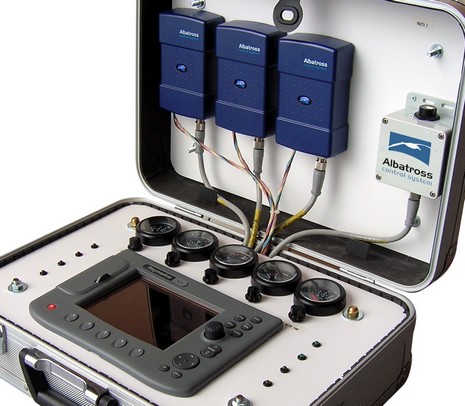Category: NMEA 2000, 0183 & Signal K
I’ve recently been beta testing a suite of software products from a marine electronics newcomer called Avia Design, and I’m tentatively enthusiastic. They are the first products I know of that are fully leveraged off the NMEA 2000 Third Party Gateway (TPG) discussed yesterday, and therefore a sign of many things to come (I think). And they’re cool, or at least should be when finished. Check out that real time polar diagram for performance sailors above — I’m not sure there’s ever been one before — and there’s plenty of power boaters too…
I’ve got a large NMEA 2000 network set up in the lab now, and it’s giving me a good chance to try out the Actisense NGT-1. It’s fully NMEA certified now, and selling for $200 at some outlets, but I gather that the Third Party Gateway system (formerly known as the Intelligent Gateway) of which it’s a part is not yet fully detailed. In other words, we don’t quite know yet how software that works with it will get NMEA approved and what, if any, restrictions there may be on how it’s sold. For instance, bundling in an NGT-1, or a similar gateway, may required. But I can tell you this: Beta versions of TPG software are starting to look powerful…
Hey, maybe I can get the NMEA riled up too (though I doubt it has the posse gCaptain does). Here’s the thing: Furuno’s FI-50 line of instruments, including the neat new Multi XL above,...
Never mind that Mercury promised a NMEA 2000 gateway to its SmartCraft engine monitoring system back in 2001, the one it’s poised to actually ship in 2010 looks quite powerful and useful. If you check out the Gateway PDF above linked to this MercMonitor gauge page, you’ll see that it can deliver a whole lot of engine messages to your N2K displays. Plus it turns out that a gent named Glen Erly has installed a prototype system and written about it in some depth…
Never mind that Mercury promised a NMEA 2000 gateway to its SmartCraft engine monitoring system back in 2001, the one it’s poised to actually ship in 2010 looks quite good. If you check out the Gateway PDF associated with the MercMonitor gauge above, you’ll see that it can deliver a whole lot of engine messages to your N2K displays. Plus it turns out that a gent named Glen Erly has installed a prototype system and written about it in some depth…
I just recently realized that Garmin has developed five analog-to-NMEA2000 adapters — the GRA 10 Rudder Angle Adapter, the GST 10 Water Speed and Temperature Adapter, the GFL 10 Fluid Level Adapter, the GET 10 Engine Tilt Adapter, and the GBT 10 Bennett Trim Tab Adapter. They each cost $199, which seems a little stiff, but then again they seem quite able at getting sensor systems you may already have onto an N2K backbone for display, or use in calculations…
The screen shot above shows MaxSea TimeZero Explorer running on Gizmo this morning, much like I showed last week. In this case you can see how I’m cranking up the radar gain, a neat right click and mouse wheel maneuver, trying to see the ship coming down the Bay. Which was really asking too much of the superb DRS2D radome because there were so many obstructions between Gizmo’s slip and the Kristen Knutsen. What’s really different about this screen is that the FA50 AIS data is finally getting to MaxSea TZ, which should have just happened given that the transponder, like the radar, is plugged into the same Ethernet switch as the MFD and the PC…
Patrick Walters had two good ideas. First, he used Maretron’s N2KBuilder to prototype a network for his Pearson 424 ketch Deep Playa (which he blogs about here). Then he sent the .n2b file (downloadable here) with the thought that he and other Panbo readers might benefit from our comments on it. I have a few…
I think I got this diagram right, and I think it’s important to understand if your boat might end up with more than a few NMEA 2000 powered devices on its network…

Rats! I took some interesting photos of an Albatross demo case similar to this in the lab yesterday, and but somehow they failed to make the trip to NYC with me last night. The company shots will do for now. Albatross Control Systems is a Spanish firm dedicated to all things NMEA 2000…

I used Actisense’s QNB-1 Quick Network Block, above and bigger here, to create Gizmo’s little NMEA 2000 network, and it pretty much lived up to expectations…











